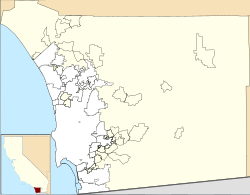Pythias Lodge Building | |
| Location | 211 E St. and 870 3rd Ave., San Diego, California |
|---|---|
| Coordinates | 32°42′52″N117°9′43.5″W / 32.71444°N 117.162083°W |
| Area | 0.1 acres (0.040 ha) |
| Built | 1911 |
| Architect | Quayle, Charles; Quayle, Edward |
| Architectural style | Beaux Arts |
| NRHP reference No. | 81000171 [1] |
| SDHL No. | 144 |
| Significant dates | |
| Added to NRHP | April 8, 1981 |
| Designated SDHL | April 8, 1980 [2] |
The Pythias Lodge Building in San Diego, California, also known as Community Arts Complex or Intercultural Council of the Arts, is a Beaux Arts architecture building built in 1911.
It was designated a San Diego Historical Landmark in 1980, [2] and it was listed on the National Register of Historic Places in 1981. [1]

However, the building was demolished during construction of the Westfield Horton Plaza. The mall includes a replica of its facade.



